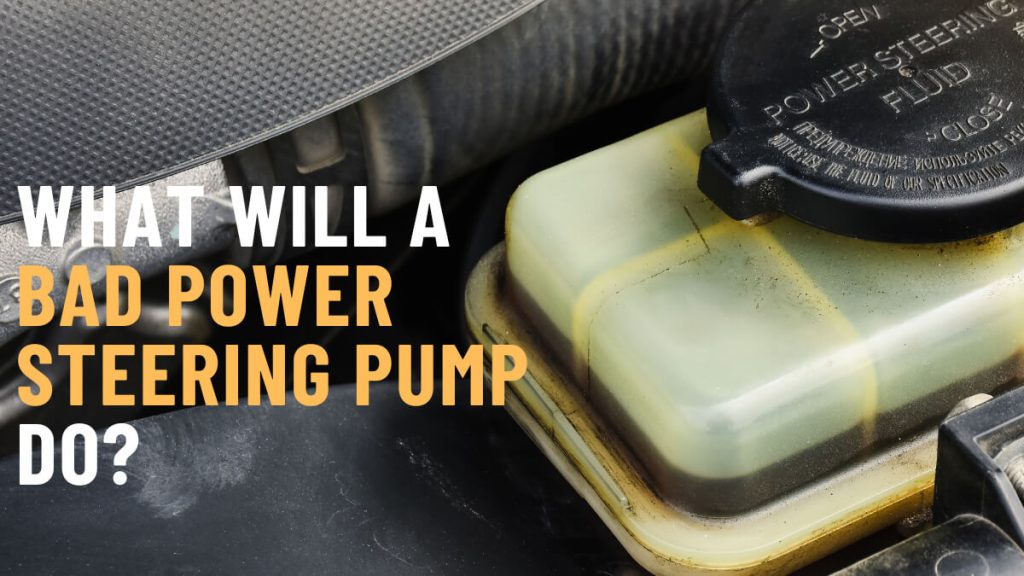November 01, 2022
Symptoms of A Bad Power Steering Pump
Want to know the symptoms of a bad power steering pump? Here is everything you need to know about power steering:
Power steering was invented in 1951 to make it easier for drivers to turn their cars. It was a remarkable technological development when automobiles began to grow larger and heavier. Moving something more serious requires more energy, especially at slow speeds.
For the car to operate effectively, certain things are necessary. While specific components might be a little more noticeable than others, they are all essential to ensuring that everything functions correctly and that you can drive your car safely. The power steering pump is one of those vital components that must be flawlessly working for your vehicle to function effectively.
The power steering pump plays a vital role in the vehicle. A power steering pump ensures that fluid reaches the power steering system of a vehicle. You’ll need it to apply the proper pressure to your wheels and make a smooth turn. So, you need to be aware of the symptoms of a bad power steering pump which you may have to watch out for.
The power steering pump is subject to wear and strain, much like any other component. A faulty power steering pump should be identified (and fixed), as it can damage your car’s handling. Any abrupt changes in your driving style could be dangerous and put you and your passengers in danger.
Let’s know more about a power steering pump and the signs of a failing pump.
What Is A Power Steering Pump?
A power steering pump in a car tends to help the driver steer the vehicle effortlessly. The power steering pump supplies the hydraulic pressure required for the system to operate appropriately. It controls the power steering fluid, making it lighter and more straightforward to manoeuvre. It is connected to your engine using a crankshaft-driven belt-pulley system.
The power steering pump helps decrease the driver’s steering effort and ensures that the driver steers the steering wheel smoothly and efficiently. It allows you to have control over the gear system of the vehicle.
After the advancement in technology, there are pumps like Electric Power Steering Pumps, Astra Power Steering Pumps, Vane power steering pumps, Roller Power Steering pumps, Slipper power steering pumps, and much more.
What Will A Bad Power Steering Pump Do?
 When your vehicle has power steering, driving becomes easier, safer, and comfier for you and your passengers. It allows you to avoid road hazards or unexpected onlookers, like animals, other vehicles, or distracted drivers. But, it’s not damage-proof or impervious to breakage.
When your vehicle has power steering, driving becomes easier, safer, and comfier for you and your passengers. It allows you to avoid road hazards or unexpected onlookers, like animals, other vehicles, or distracted drivers. But, it’s not damage-proof or impervious to breakage.
A bad power steering pump might become noisy. It can happen for various reasons, including loose or slipping belts, damaged bearings, or air in the hydraulic system. A slipping belt or frothy fluid may make the steering feel weird, in addition to the noise, which can be bothersome.
Your vehicle will either have reduced or no steering assistance if fluid pressure loses out in a hydraulic power steering system. When this happens, your vehicle’s steering system will revert to the manual process. As a result, having to turn the steering wheel will be extremely difficult. In other words, your 2000s car would handle similarly heavy to a 1960s car, making driving difficult and exhausting, especially at low speeds.
7 Symptoms of A Bad Power Steering Pump
The power steering pump is subject to wear and strain, much like any other component. A bad power steering pump should be identified (and fixed), as it can damage your car’s handling. Any abrupt changes in your driving style could be dangerous and put you and your passengers in danger. The following are the seven most common symptoms of a bad power steering pump:
1. Squealing Noise While Starting The Vehicle
The power steering pump may malfunction when you start your car and cause a squealing sound. Whenever you start your vehicle, this usually lasts for around a minute. These noises are frequently the result of a worn-out pump or low fluid levels. It’s best to avoid jumping to conclusions because various problems might make squealing noises; otherwise, you might waste a lot of time and money.
2. Grey Power Steering Fluid
The grey fluid in the power steering fluid signifies that it has oxidized and the pump is not working in proper condition. When the liquid turns grey, it makes the pump unclean and damages it. Oxidization takes place in the power steering reservoir. One can determine if there is a power steering issue based on the air in the pump.
One should have the fluid checked quarterly to avoid the symptoms of a bad steering pump, which may also harm other components.
3. Stiff Car Steering Wheel
The steering wheel of a car won’t function if there is a power steering pump issue. The steering wheel will be rigid, and it won’t be easy to turn, making it very difficult for the driver. If you experience difficult or stiff steering while driving, you should carefully park the car nearby, take it to the service shop, and have the steering pump replaced.
4. Groaning Noises
If you notice a loud groaning sound coming from your car while driving, the steering pump might be one of the issues. It might denote a fluid shortage in the pump, which impacts the pump and other components of the car.
One should have the steering pump either changed or serviced with the assistance of a mechanic if it continues to grow over time.
5. Slow Responding Steering Wheel
One can check for issues with the steering wheel by rotating the steering wheel in different directions. If the wheel responds slowly, it means the steering pump is malfunctioning. This sign of a malfunctioning power steering pump might be dangerous because the driver was counting on the wheel to react quickly so the car could function as intended. If a person notices this symptom while driving, they should park the car and call for help from a professional.
6. Low Power Steering Fluid Level
The fluid level is crucial to the pump’s operation. The steering pump will suffer harm if there is a low liquid level or no fluid in the pump.
Examine the fluid level to make sure it falls within the acceptable range. There ought to be a low and a full mark on the reservoir. If there are any leaks between the pump and the pool, fix them to stop additional damage. A significant indication that the power steering pump may malfunction is the presence of a puddle below the car that is often crimson or reddish-brown.
7. Power Steering Symbol on the Dashboard
If the motor vehicle has an electric steering pump, it will always show a power steering symbol on the dashboard. There is always a power unit that controls the steering of the vehicle.
If there is some fault in the steering pump, the dashboard will lighten up and warn the driver. The symbols could be the Engine check warning light, service engine soon warning light, washer fluid level warning sign, and so on.
Conclusion
One of those crucial components that must function correctly for your car to function properly is the power steering pump. You need to be aware of the symptoms of a bad power steering pump.
A malfunctioning power steering pump may make your car squeal even when you turn the key in the ignition. Your pump is most certainly starting to fail if these noises continue even after you have examined and refilled the power steering fluid region.
The vehicle’s steering stability reduces without a properly working steering pump. Hence, it is advisable not to drive if your steering pump fails. Instead, take your car to a steering service and get it replaced. Depending on the location and vehicle maintenance, the cost of a professional power steering pump replacement varies significantly. The typical price ranges from $350 to $700!

